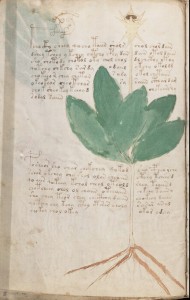Plant 42v spans most of the page in the vertical direction. There are two text blocks crossing the upper and lower stalks. This page, even more than others, demonstrates how the integration of the text and the plant appear to be planned. One thing to note about the text is the final trailing characters on the bottom right. It’s rare for a VM “paragraph” to end on the right with a gap. This is seen only in a few places and the anomalous placement appears to be deliberate, since there’s room for the characters on the left of the stem.
Also note on this page the highly embellished first character on the top left. It is ornate in the manner of illuminations, but in a quirky individualistic style.
Plant Details
In terms of overall shape, this plant is similar to 5r, with a long stalk, a whorl of leaves, another stock and a flower head at the top.
The plant leaves are fairly large and painted a fairly consistent green, although the one on the left is a little lighter on the inside as though the pigment were diluted to last longer or to create a lighter shade. The margins appear to be relatively smooth, even if a bit irregular, rather than serrated.
The long roots that angle outward are reddish brown, and the flower head appears to have been filled in with the same brown ink used for the text.
The most distinctive feature is the shape of the single flower head which appears to include spurs. If the extra protrusions were sepals, they would probably have been painted a darker color, as was done in other VM illustrations. The cup-like center also stands out.
Prior Identification
Edith Sherwood has identified this plant as Aquilegia vulgaris (Culverwort). This doesn’t seem likely. Aquilegia vulgaris has palmate leaves and they are more thickly concentrated near the ground. In contrast, Plant 42v has elliptical leaves that are clustered some distance up the stem. More likely this is Trientalis europaea (Chickweed wintergreen), Trientalis borealis (Western star flower). One might consider one of the Epimediums, which have very distinctive spurs and a cupped center similar to this plant.
Epimedium and its Medicinal Reputation
Depending on the species, Epimedium spurs can be long or short, straight or curved, and the position of the petals or colored bracts can make it look almost like two sets of spurs. The center generally always has a cup-shaped group of blossoms and the pistil protrudes to various degrees, sometimes beyond the central “cup”, sometimes not.
Some of the Epidemiums (e.g., E. macranthum, E. sagittatum) have chemicals that promote hormonal effects in animals and sometimes humans. The plant is known as Horny Goat Weed and there are studies that suggest that goats who eat it have a higher sperm count. The plant is also included in a number of weight training products. Further, it is historically reputed to prevent breasts from growing too large when administered to women and is known by the name of barrenwort, which suggests that it may hinder conception and/or work as an abortifacient. It appears that the plant may have an effect similar to testosterone.
While the spurs make it tempting to identify this plant as a species of columbine, the overall shape and leaves don’t resemble columbine. It is closer to Epimedium, especially with the cupped flower and spurs. Columbine flowers are somewhat cupped, but the inner “cup” is not as rounded as Epimedium. Also, Columbine stamens tend to protrude more than Epimedium and would probably have been show in the VM drawing.
Epimedium isn’t a match, however. It typically has serrated or slightly spiny leaves and more often than not, the leaves are asymmetric, like begonia leaves. So while the flowers more closely resemble Epimedium than Aquilegia, the leaves and their arrangement do not. Epimedium flowers are numerous and, like Columbine, they tend to nod.
Halenia also has spider-like spurs, but the centers can be variable, sometimes cup-like, sometimes like the head of a bullet. The leaves come closer to Plant 42 than either Aquilegia or Epimedium.
ROUGH DRAFT TO BE CONTINUED
Halenia perrottetii Halenia umbellata
Posted by J. Petersen
Possible Alternatives


